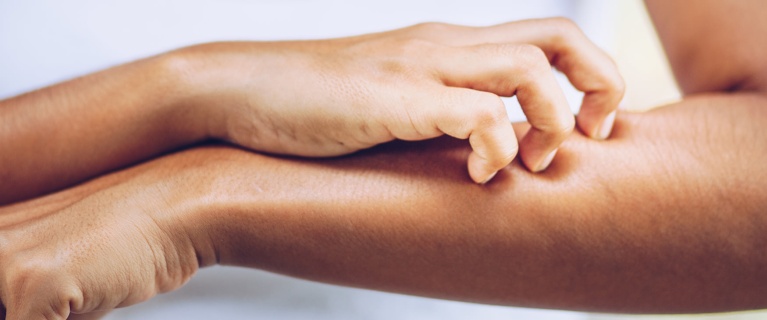

List of the different types of eczema

Eczema (also called dermatitis) is a particular type of inflammation of the skin. It often appears as patches and is characterized by redness, swelling, pain and especially itching (pruritus). These patches can ooze (acute eczema), peel, form scabs, or even thicken (lichenification) in chronic cases.
The different types of eczema can be classified and identified in a number of ways. In terms of causes and mechanisms, there are two major types: atopic eczema and contact eczema.
Atopic eczema
Atopic eczema is a chronic hereditary condition with alternating periods of eczema flare-ups and remission. It is caused by a malfunction in the skin, which becomes more sensitive to its environment. Atopic eczema is the skin manifestation of atopy, just as asthma is its respiratory manifestation.
Contact eczema
Contact eczema occurs when skin comes into contact with a common allergen (nickel in costume jewelry) or irritant (overuse of soap). In case of allergy, skin tests help identify the agent responsible so that it can subsequently be avoided in order to treat the condition.
Are there other types of eczema?
Certain conditions may indeed be eczema, even though the term “eczema” does not appear in the name. Similarly, some conditions that use the term “eczema” are not actually a type of atopic eczema or contact eczema.
For example:
- Dyshidrosis, appearing on the hands and feet, may be due to a contact allergy, a fungus infection (mycosis) or even abnormal sweating.
- Bullous eczema, a particular form of eczema caused by the coalescence of vesicles that form bubbles.
- Protein contact dermatitis may appear initially as urticaria immediately upon contact with the causative substance, and subsequently as eczema. It is linked to contact with plant or animal proteins (e.g. wheat proteins).
- Varicose eczema affects the legs, sometimes appearing around a wound. It is aggravated by venous insufficiency (varicose veins or a history of phlebitis) or possibly by a contact allergy.
- Nummular eczema, also known as discoid eczema, manifests as round coin-shaped patches. It may be caused by a contact allergy or can occur in patients with atopy. Sometimes, the cause is unknown.
- Chronic hand eczema may be caused by contact with an allergen or irritant but can also appear along with atopy.
Some conditions may look like eczema but, in fact, are not:

